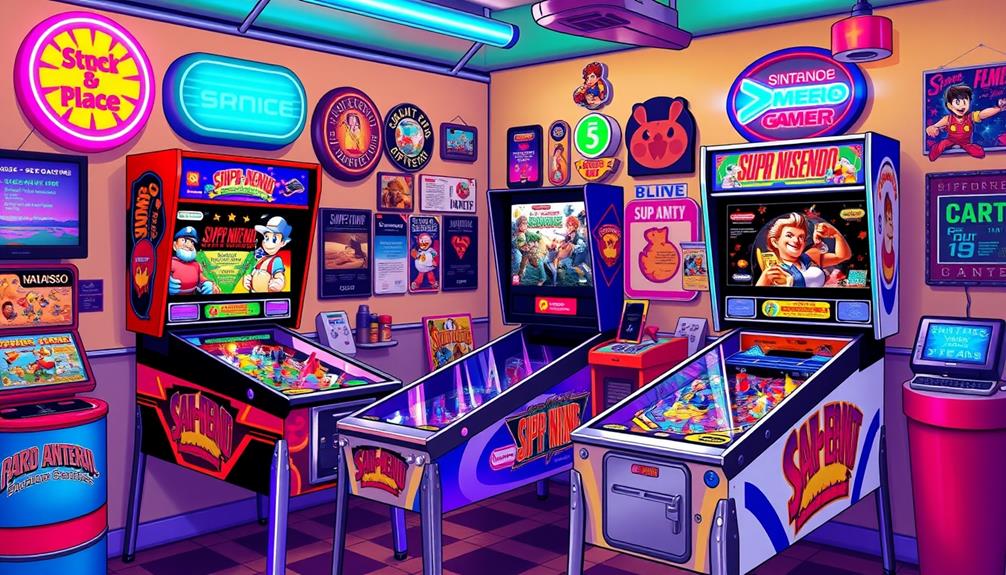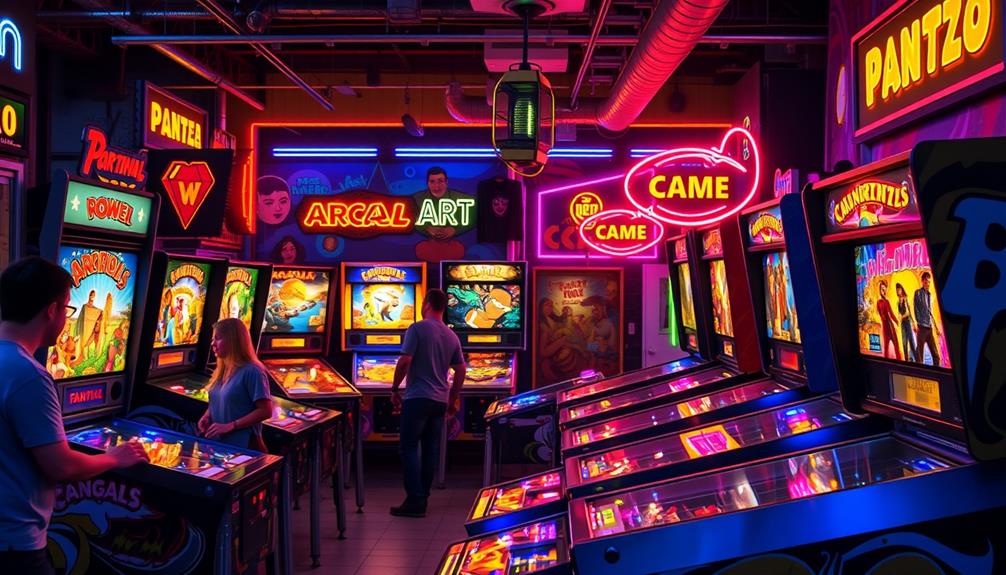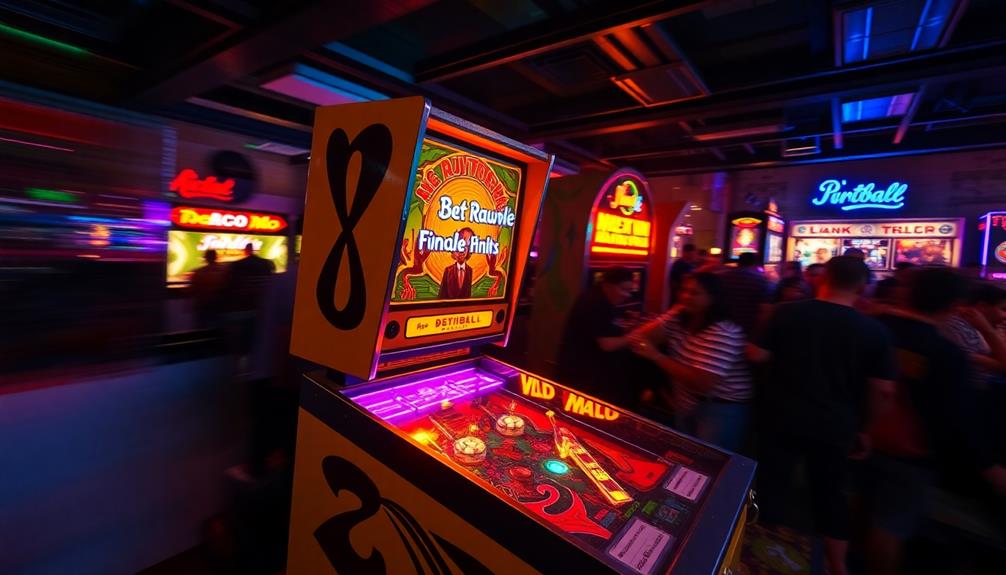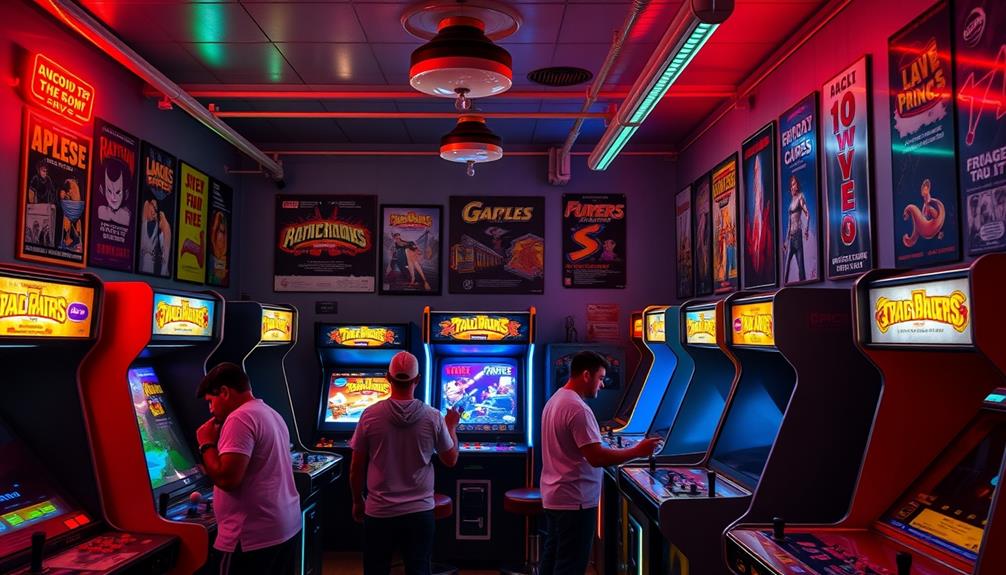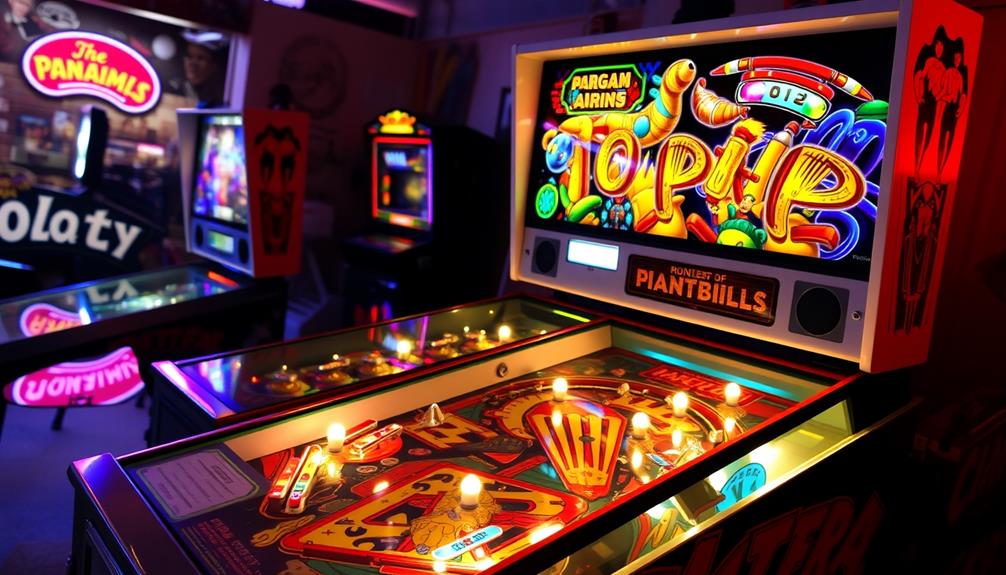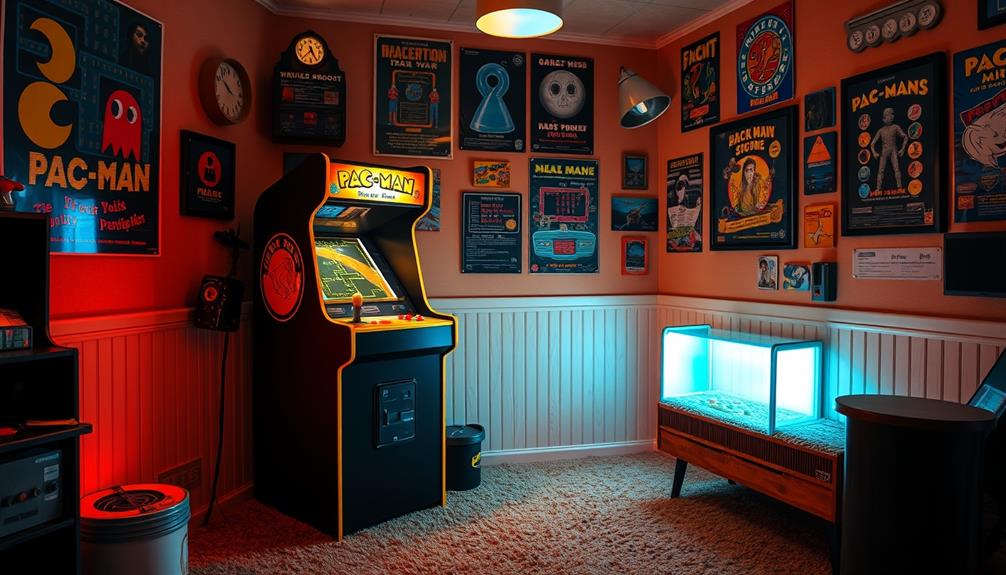Pinball machines operate by combining both mechanical and electronic components to deliver an immersive gaming experience. Players use flippers controlled by buttons located under the glass to navigate the ball as it moves down the slanted playfield, interacting with bumpers and ramps to earn points based on successful hits. Electronic systems keep track of your progress and display it on a dot-matrix screen, while a tilt mechanism ensures fair gameplay by preventing excessive shaking. Scoring requires a combination of skill and strategy, with the potential to unlock jackpots and free games. Dive deeper into unraveling the fascinating intricacies of how these machines function!
Key Takeaways
- Pinball machines feature an inclined playfield where players control the ball using flippers to hit targets and score points.
- Scoring involves hitting specific targets and achieving combination shots to activate jackpots, displayed on a dot-matrix screen.
- The tilt mechanism prevents excessive shaking, ensuring fair play by terminating the game if the machine is jolted too much.
- The replay value system rewards players with free games for reaching high score thresholds, encouraging strategic gameplay.
- Community events and online platforms foster engagement, allowing enthusiasts to share knowledge and troubleshoot machine issues.
History of Pinball Machines
Since their inception, pinball machines have undergone a remarkable transformation. The journey began with the release of "Humpty Dumpty" in 1947 by Gottlieb, marking the start of modern pinball. Initially, these machines were purely mechanical, but as technology advanced, they began incorporating electronic components that enhanced gameplay.
The golden age of pinball in the 1970s and 1980s saw a surge in innovative designs, with a variety of themes enchanting players, reminiscent of the evolving styles seen in celebrity fashion and style during events like the Met Gala.
The late 1980s brought a significant milestone: the introduction of the dot-matrix display. This innovation revolutionized player interaction, allowing for real-time scoring and gameplay hints, making the experience more engaging.
Even when the industry faced challenges in the late 1990s, companies like Stern Pinball emerged as key players, focusing on nostalgia while introducing modern themes to attract dedicated fans.
Today, you can still find machines that harken back to classic designs, while also embracing cutting-edge technology. The evolution of pinball machines reflects not just a change in technology, but also a deep connection to player experience, making them timeless entertainment.
Key Components of Pinball Machines
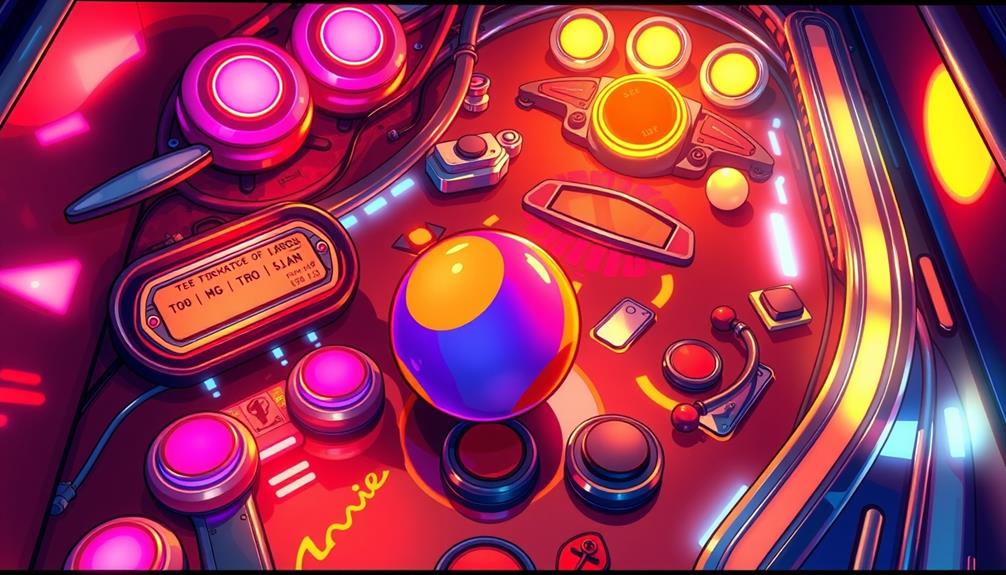
When you step up to a pinball machine, you're greeted by a fascinating array of key components that work together to create an exciting gaming experience. Each element plays a vital role in how the game unfolds: understanding the mechanics can enhance your enjoyment, much like how budgeting is essential for financial health.
- Flippers: Located at the bottom of the playfield, these are your primary tools for keeping the ball in play. You control them with buttons beneath the glass top.
- Playfield: This inclined surface, made of wood, is where all the action happens. Its angle enhances the ball's movement and interaction with various obstacles.
- Backbox: This houses the main electronics, including the dot-matrix display, which tracks scoring and provides gameplay hints, along with beautiful backglass art.
- Bumpers and Ramps: These features add dynamism to the gameplay, bouncing the ball around the playfield and directing it toward scoring opportunities.
The intricate wiring connects these components to the main controller, ensuring everything operates smoothly.
As you play, you'll quickly appreciate how these key components come together to create the thrill and excitement of pinball.
How Scoring Works
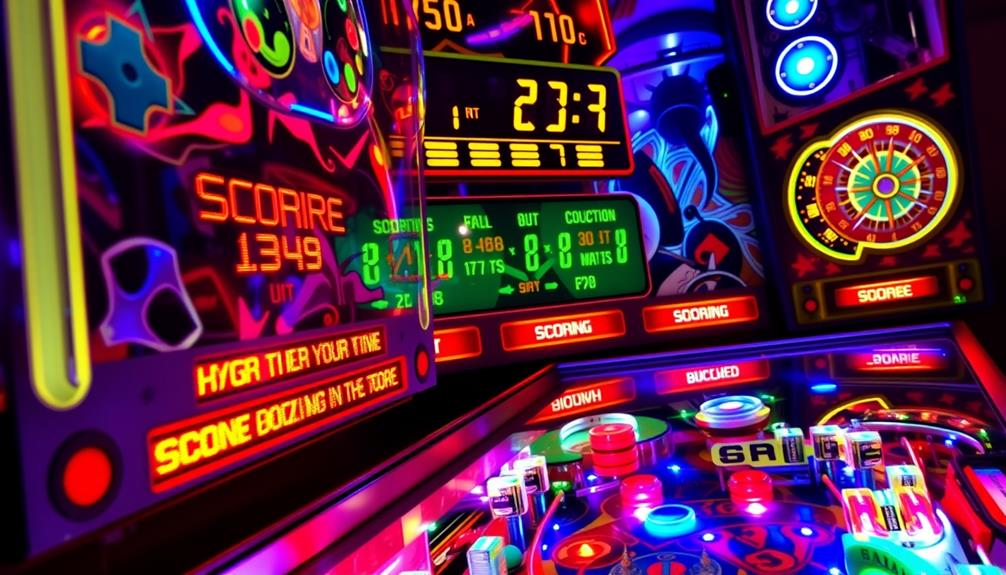
In pinball, scoring isn't just about hitting targets; it's a strategic game that can lead to big bonuses.
As you navigate the playfield, you can also experience a sense of nostalgia that comes from mastering the game's mechanics, akin to the joy found in Blue Skies and Lemonade by Rhythm Failure.
You can access jackpots by mastering specific shot combinations, while the replay value system offers rare chances for free games.
Plus, don't forget to keep an eye on the match feature at the end of your game for a shot at even more rewards!
Scoring Mechanisms Explained
One of the exciting aspects of playing pinball is understanding how scoring works. Knowing the different scoring options can help you score points and keep your game going.
Here are some key mechanics to pay attention to:
- Combination Shots: Mastering these can activate jackpots and score more points, giving you a significant advantage.
- High Roller Machines: These feature poker-like scoring, where hitting specific targets allows you to complete sequences for big rewards.
- Match Feature: At the end of the game, a two-digit number is randomly selected. If it matches the last two digits of your score, you could win additional credits!
- Real-Time Updates: The dot matrix display provides current scores and hints, helping you identify scoring opportunities as you play.
Replay Value System
The replay value system in pinball machines offers you a thrilling incentive to elevate your gameplay. By achieving specific score thresholds, typically set within the top 10% of scores, you can earn free games. This system reflects a broader trend in gaming where the importance of understanding regulations can influence your overall experience.
You'll notice that the required score for a replay value is displayed on the machine, with the next threshold often set at 150% of the first, making it progressively challenging.
As you play, audio signals will alert you when you reach these replay value thresholds, enhancing your engagement and excitement. At the end of each game, you have the chance to activate the match feature, where a random two-digit number is selected. If your score ends with those digits, you've got a 7% chance of scoring a free game.
To maximize your chances of reaching replay value criteria, experienced players often strategize. They focus on executing combination shots that can trigger jackpots and scoring bonuses, which can greatly boost your score.
Match Feature Overview
At the end of your pinball game, a surprise awaits as the match feature kicks in, adding an exciting twist to your scores. This feature randomly selects a two-digit number (00-90) after the final score is tallied. If it matches the last two digits of your player score, you win a free game! With a typical probability of 7% or less, this element of luck provides an additional incentive to aim for high scores. Engaging with this element of chance can boost your overall enjoyment, similar to how curiosity fosters social connections and relationships.
Here's what makes the match feature so captivating:
- Random Selection: It adds unpredictability, making every game feel unique.
- Free Game Opportunity: You can extend your gameplay without spending more money.
- Heightened Player Engagement: Players enthusiastically anticipate the match, enhancing their overall experience.
- Chance for Extra Plays: Even if your score falls short, you still have a shot at more fun.
The match feature serves as a fun conclusion to each game session. So, after you've battled for your score, remember that luck might just grant you those extra plays you're hoping for!
Tilt Mechanism Explained

In pinball machines, the tilt mechanism plays an essential role in ensuring fair play. When you shake the machine too much, a pendulum bob touches a metal ring, signaling a tilt and potentially ending your game after repeated warnings.
This mechanism can be likened to the importance of open dialogues in relationships, as both help maintain balance and fairness. Understanding the types of tilts and how they impact gameplay can help you balance your strategy and avoid losing your turn.
Tilt Sensor Functionality
Understanding how the tilt sensor functions is vital for any pinball enthusiast, especially since a well-optimized gameplay experience relies on fair play mechanics. The tilt sensor plays a significant role in maintaining fairness by detecting excessive movements that could disrupt gameplay. Here's how it works:
- Pendulum Bob Movement: A pendulum bob hangs freely inside the machine.
- Conductive Ring Contact: When the pendulum bob swings and touches the conductive ring, it triggers a tilt.
- Warnings Issued: Players receive two warnings when a tilt is detected due to moderate shaking of the machine.
- Game Termination: If extreme abuse occurs—like lifting or kicking the machine—this results in immediate game termination.
These mechanisms guarantee that players balance their aggression with caution. The tilt sensor's purpose is to prevent any unfair advantage, making the gameplay more enjoyable for everyone.
By understanding this functionality, you can better appreciate the intricacies of pinball and avoid unnecessary game interruptions. So next time you're playing, remember to keep your cool and avoid actions that could trigger a tilt!
For more insights on content quality, consider how such details enhance the overall experience.
Types of Tilts
Players often encounter different types of tilts while engaging with pinball machines, each with distinct consequences based on the severity of the actions taken. The tilt mechanism consists of a metal ring and a pendulum bob. If you shake the machine excessively, the bob can contact the ring, triggering a tilt that affects your gameplay strategy.
| Tilt Type | Description | Consequences |
|---|---|---|
| Standard Tilt | Two warnings before game termination | Lost ball opportunities |
| Slam Tilt | Immediate game termination due to abuse | Game over, no second chances |
| Minor Tilt | Light shaking, sometimes just a warning | Temporary gameplay disruption |
| No Tilt | Fair play maintained, smooth gameplay | Opportunity for maximum points |
The tilt sensor guarantees fair play, preventing players from gaining an advantage through aggressive shaking. With modern machines having adjustable tilt sensitivity, you must find the right balance in your gameplay strategy. Remember, excessive shaking can lead to lost ball opportunities and even game termination, so play smart and keep the fun going!
Impact on Gameplay
The tilt mechanism significantly impacts gameplay by enforcing rules that maintain fairness and challenge. It's designed to prevent cheating through excessive shaking, which can unfairly sway outcomes.
When you play, this mechanism guarantees a balanced experience, promoting fair play and excitement. Additionally, just as essential oils like eucalyptus oil can provide decongestant effects for soothing sinus issues, the tilt mechanism acts as a safeguard to enhance the overall enjoyment of the game.
Here's how it works:
- Detection: The tilt mechanism uses a metal ring and a pendulum bob. If you shake the machine too much, the bob touches the ring, triggering a tilt signal.
- Warnings: Most modern machines give you two warnings for a standard tilt before suspension of gameplay occurs.
- Slam Tilt: If you go overboard with aggressive actions, a slam tilt leads to immediate game termination.
- Flipper Use: This mechanism encourages strategic flipper use, balancing aggression with caution to keep your turn alive.
Gameplay Mechanics
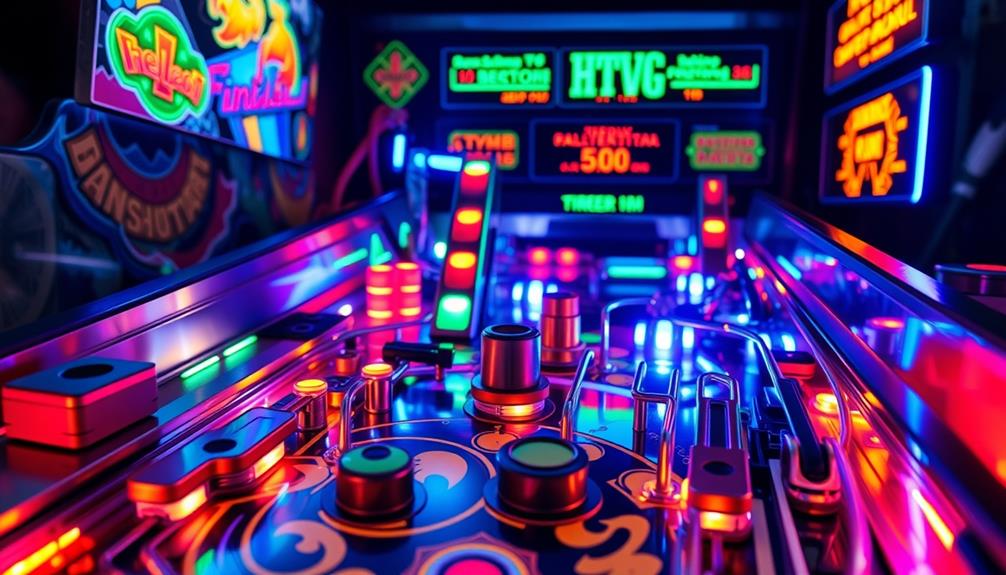
Pinball machines combine skill and strategy, creating an engaging gameplay experience. As you navigate the playfield, you'll use flippers to launch the ball toward various targets and bumpers, aiming for high scores. Scoring is visually represented on a dot-matrix display, helping you track your progress and strategize your next moves.
Here's a quick overview of key gameplay elements:
| Feature | Description | Impact on Gameplay |
|---|---|---|
| Targets | Designated spots to hit for points | Activate jackpots and bonuses |
| Jackpots | Special scoring opportunities | Increase your total score considerably |
| Tilt Mechanisms | Sensors preventing excessive shaking | Protects the game integrity; issues warnings |
You'll find that hitting specific targets can activate jackpots and scoring bonuses, especially on high roller machines with poker-inspired mechanics. The replay value system rewards you with free games when you reach top scores, while the match feature at game's end offers a chance for extra play. Just remember not to trigger the tilt mechanisms, or you risk losing your game!
Ball Dynamics
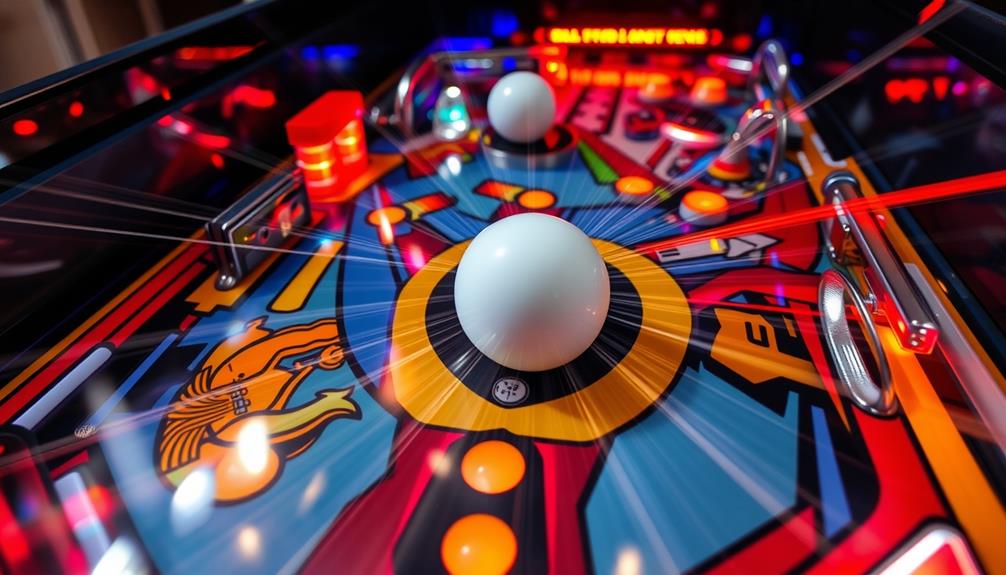
Understanding ball dynamics is key for mastering pinball. The interplay of gravity, speed, and obstacles on the playfield creates exciting challenges that you'll need to navigate.
Additionally, much like the importance of energy-efficient appliances in reducing power consumption, recognizing how to control the ball's movement can greatly enhance your play.
Here are four vital aspects of ball dynamics to take into account:
- Playfield Incline: With a typical slope of 6-7 degrees, the incline affects how the ball rolls and interacts with obstacles.
- Ball Speed: Standard pinball balls can reach speeds up to 90 mph on unwaxed tables. This high speed demands quick reflexes and precise flipper control.
- Obstacles: Ramps, bumpers, and targets create scoring opportunities. Each obstacle alters the ball's path, requiring you to anticipate its movement.
- Ball Weight: Weighing 2.8 ounces, the ball's mass influences how it reacts to interaction with flippers and other elements on the playfield.
Industry Trends
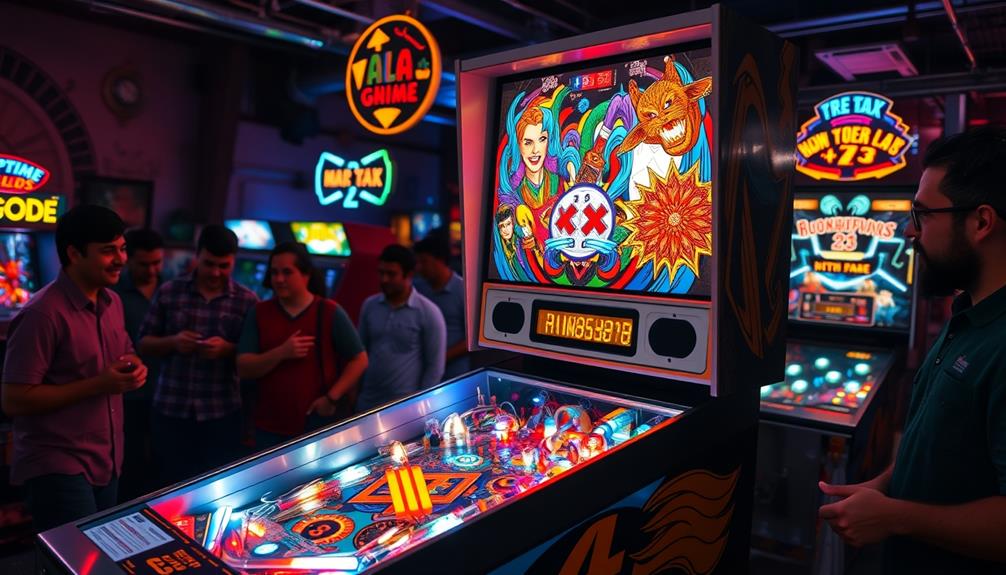
As you explore the pinball industry today, you'll notice a fascinating mix of nostalgia and innovation shaping its future.
While traditional machines still attract dedicated fans, technology integration is introducing fresh gameplay experiences, reminiscent of how cruise ships operate as floating cities that require complex management.
However, market trends reveal both challenges and opportunities that could redefine how you engage with pinball.
Nostalgia and Retro Appeal
There's something undeniably enchanting about the nostalgia and retro appeal of pinball machines that continues to draw players in, especially those between 18 and 35.
Despite the rise of digital gaming, pinball offers a unique tactile experience that you can't replicate on a screen. The classic arcade environment fosters social interaction, making it an attractive choice for a dedicated player base.
Here are a few reasons why pinball remains so enthralling:
- Nostalgia: Many players fondly remember the thrill of playing as kids, sparking a desire to relive those moments.
- Collectible Value: Vintage machines often see high prices at auctions, making them coveted treasures for enthusiasts.
- Artwork and Themes: The stunning designs and engaging themes resonate with players, elevating each game into an art form.
- Classic Arcade Vibes: There's a nostalgic magic in the sounds and lights of a pinball machine that digital gaming just can't replicate.
As Stern Pinball continues to produce new machines based on beloved themes, the retro appeal of pinball shows no signs of fading away.
Technology Integration Innovations
While nostalgia fuels the passion for pinball machines, the industry is also embracing technology to attract a younger audience. Companies like Stern Pinball are producing 3-4 innovative machines annually, integrating advanced technology that enhances gameplay. High-resolution dot-matrix displays provide vibrant visuals, while digital sound systems deliver immersive audio experiences, amplifying player engagement.
These innovations not only enhance the thrill of playing but also offer real-time feedback, keeping players invested in their game. The previous Pinball 2000 concept showcased early attempts at mixing video gaming with traditional mechanics, paving the way for further technology integration.
As the market evolves, you can expect to see even more exciting developments, such as virtual reality experiences that blend the physical and digital domains. This shift aims to energize the pinball scene while maintaining the essence of what makes it unique.
Nostalgia still plays a significant role, driving demand for collectible machines adorned with unique artwork that resonates with both long-time fans and newcomers.
Market Trends and Challenges
Despite the nostalgic allure of pinball machines, the industry faces significant challenges as it attempts to navigate shifting market trends. The decline since its peak in the 1970s and 1980s has left only Stern Pinball among the original manufacturers.
However, they target the 18-to-35 demographic, especially in Europe, planning to release 3-4 new machines annually.
Here are some key trends impacting the pinball market:
- Digital Gaming Competition: The rise of mobile apps and digital games draws potential players away from traditional pinball.
- Nostalgia Appeal: Despite this, a dedicated player base remains, fueled by a strong sense of nostalgia and community.
- Collectible Value: The unique releases and artwork of pinball machines influence their collectible value, making limited-edition models highly sought after.
- Advanced Technologies: Future developments may integrate virtual reality and other advanced technologies to enhance gameplay, appealing to tech-savvy younger audiences.
Incorporating these elements will be essential for the industry to thrive amid evolving consumer preferences and technological advancements.
Community Engagement

Engaging with the pinball community opens up a world of collaboration and shared knowledge that enhances your experience as an enthusiast. By participating in community events, you can plunge yourself into skill sharing and networking among fellow enthusiasts. These gatherings foster connections and allow you to learn from others who share your passion.
Online platforms, like forums and wikis, serve as invaluable resources where you can engage community members and contribute collaboratively. The open editing policy encourages you to share knowledge and improve these resources collectively, ensuring that everyone benefits.
You'll find a wealth of troubleshooting advice on these platforms, helping you navigate challenges while working on or enjoying pinball machines. Participating in discussions online not only broadens your understanding but also sparks innovation in pinball design.
By exchanging ideas and experiences, you contribute to a vibrant ecosystem of creativity and problem-solving. Embrace the opportunity to learn from others and share your insights, as community engagement is key to enhancing your journey as a pinball enthusiast.
Don't hesitate to plunge in; the knowledge and camaraderie await you!
Tools and Technology
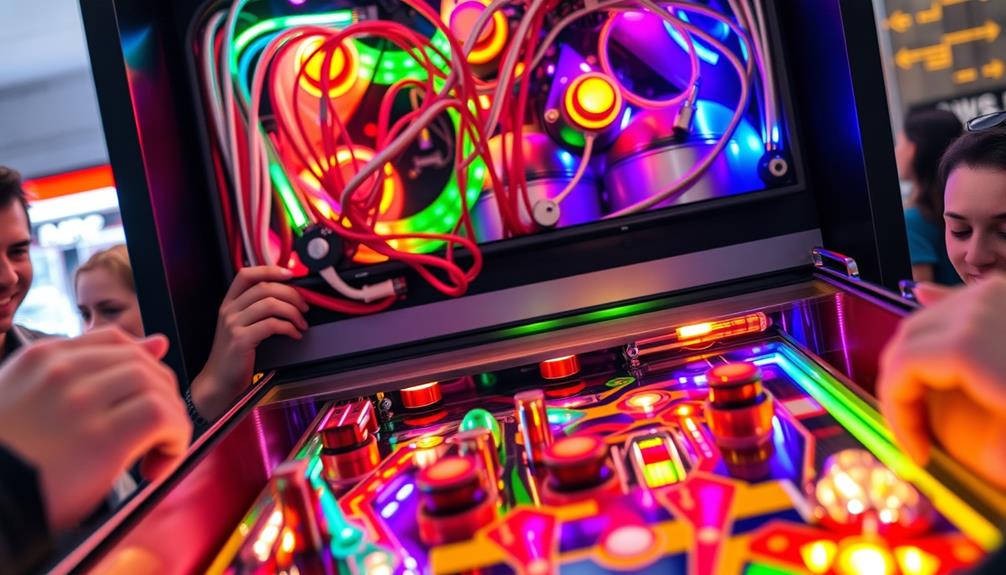
In the world of pinball, innovative tools and technology play an essential role in designing and building machines that capture the imagination. The advances in technology have made it possible for hobbyists and professionals alike to create stunning pinball machines with precision and flair. These advancements in technology have also led to improvements in the pinball machine mechanisms, allowing for more intricate and interactive gameplay experiences. From more sophisticated flippers and bumpers to advanced scoring and lighting systems, the modern pinball machine is a marvel of engineering and design. As a result, the appeal of pinball continues to grow, attracting new enthusiasts who appreciate the marriage of vintage charm and cutting-edge technology.
Here are some key tools shaping the industry:
- CNC Routers: These are used for cutting materials with high accuracy, producing complex shapes essential for machine parts.
- Laser Cutters: They provide clean edges and intricate designs, enhancing both the aesthetic quality and functionality of components.
- 3D Printers: Employed to create custom parts and prototypes, these printers facilitate rapid development and testing of new designs.
- CAD Software: This software enables designers to create intricate layouts and components efficiently, ensuring every detail is accounted for.
Thanks to the accessibility of these advanced tools, home workshops can now produce professional-quality pinball machines.
Whether you're a seasoned designer or just starting, these technologies empower you to bring your ideas to life and push the boundaries of what's possible in the pinball world.
Design Considerations

With advanced tools at your disposal, the next step in creating an enchanting pinball machine involves thoughtful design considerations. The layout of a pinball machine notably impacts gameplay experience and flow, influencing how players interact with various components during play.
You'll want to make aesthetic choices that enhance visual appeal and branding, as eye-catching artwork on the playfield and backglass can attract players. Incorporating themes into the machine design can elevate player engagement, making the gameplay experience more immersive and enjoyable.
It's essential to balance challenge and accessibility to guarantee both novice and experienced players find the game engaging without feeling frustrated. Prototyping and testing are critical steps in the design process. They help you refine gameplay mechanics and overall machine functionality before final production, allowing you to identify any adjustments needed for a smoother experience.
Frequently Asked Questions
How Does a Pinball Machine Work Step by Step?
To understand how a pinball machine works step by step, you launch the ball, use flippers to keep it in play, hit targets for points, and watch the score display as you navigate the playfield.
What Is the Science Behind the Pinball Machine?
Imagine a silver ball dancing through a vibrant maze, where gravity pulls it down and flippers launch it skyward. You're witnessing Newton's laws in action, guiding each thrilling bounce and spin, igniting your competitive spirit.
What Is the Trick to Pinball?
The trick to pinball is mastering flipper control and understanding your machine's scoring. You'll maximize points by timing your shots, avoiding tilts, and familiarizing yourself with the playfield layout to enhance your gameplay experience.
How Did Old Pinball Machines Work?
Did you know that vintage pinball machines often had over 100 mechanical parts? You launched the ball with a plunger, aimed at targets, and watched as bumpers activated, tracking your score on rotating reels.
Conclusion
To sum up, pinball machines are like intricate puzzles waiting for you to solve them. From their rich history to the latest design trends, each element invites you to engage and compete. Understanding how they work enhances your gameplay, making every flip of the flipper an exciting challenge. As you immerse yourself in the vibrant community and evolving technology, you'll find that pinball isn't just a game; it's a thrilling journey that connects players across generations.

